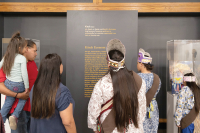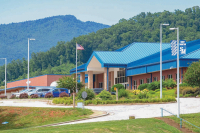Front row seat to history
 Randall E. Murff remembers the guns shooting at him.
Randall E. Murff remembers the guns shooting at him.
“The Germans really could shoot those guns, they were good,” he said. “If you gave them 17 seconds, they’d knock you right down.”
Sitting in his living room in a quiet, unassuming home on the back roads of Sylva, Murff rocked slowly in his recliner. He was 24 years old when the Germans wanted him dead. Now 94, he vividly remembers the sights, smells and noises on D-Day, June 6, 1944. This year marks the 70th anniversary of that turning point in the European theatre of World War II, one that eventually led to the Allied defeat of the Axis powers.
The D-Day landings are considered some of the bloodiest battles of the war, with thousands of soldiers killed before the bullets stopped flying. It is also the largest seaborne invasion launched in human history, with more than 150,000 Allied troops (United States, England, Canada, etc.) storming the beaches of Normandy and punching a hole into the German western battlefront.
A nose gunner in the front of the plane, Murff was part of a B-26 bomber crew that led the first wave of attacks on D-Day. Leaving from an airbase in England early that morning, his crew headed across the English Channel for French soil occupied by the German Nazis.
“Our bombs were away at 6:23 a.m. and the boys hit the beaches at 6:30 a.m.,” he recalled. “We could see all of the boys and the ships heading for shore — it was quite a sight.”
Related Items
Mississippi Farm Boy
Born on Nov. 16, 1919, on a farm outside of Calhoun City, Miss., Murff was one of seven boys, and the second oldest in the family after his sister. Eight siblings total, all growing up during the Great Depression.
“I grew up on a farm about a mile outside of town,” he said. “Dad was a tractor mechanic and we come up through the Depression, a time when you really had to work.”
Following high school graduation, Murff went to Mississippi State University for a stint, only to then find work at a nearby Chevrolet dealership. Eventually, he turned 21 years old and was drafted. He applied to the Army Air Corps in hopes of becoming a pilot but was denied due to a scar on his eardrum.
“It really tipped my sails when I was turned down,” he said. “So, I just enlisted in the Army, where I had planned to be for the next 12 months and then go home, and that didn’t happen of course.”
The change in his plans came when he jumped on a bus to join the Army in Hattiesburg, Miss. The day was Dec. 4, 1941 when he arrived at the base. Two days later, he was officially in the Army. On the third day, Dec. 7, Murff was standing in the chow line at the cafeteria when word broke that the Japanese had attacked the United States at Pearl Harbor in Hawaii.
“I had no idea where Pearl Harbor was when I heard about the attack,” he said. “My geography had not included that place.”
With the United States jumping into World War II, Murff was sent to an airplane mechanics school in Texas. He once again wanted to try and become a pilot. Desperate for pilots with war breaking out and planes being built as fast as they could, soldiers were only given eight hours of training before they had to take a solo flight test to see if they were qualified. Murff again didn’t become a pilot, but he did however end up going into gunner school in Las Vegas. From there, he enrolled in bombardier/navigator school and soon joined a twin-engine B-26 bomber crew in Tampa.
Chosen to be a nose gunner, which meant he would man a gun in the glass nose of the front of the bomber, Murff would be front row for air battles, with his observations and intuitions used to guide the plane into the correct course of action.
“I had no fear, I wasn’t afraid of anything,” he confidently stated. “Fear was not in my book.”
Once he had his crew, Murff took off in the spring of 1943 to Detroit to pick up 56 brand new planes as part of the 387-fighter group. They flew back down to Georgia, up to Norfolk, Va., onward to Presque Isle, Maine, and Goose Bay, Labrador, then across the North Atlantic Ocean to a base in Greenland.
“That base was carved out of the side of a mountain and you landed right at the water level coming in to the runway,” he chuckled. “So, when you took off, you shot down the hill and towards the ocean. If you didn’t get the plane in the air in time, you’d hit the water.”
After a couple more stops in Iceland and Scotland, the bomber crew finally landed at their base in England, Station #163, just northeast of London.
European Battle Zone
Once in England, Murff spent the next year flying missions. Some days they’d bomb airfields, while others they’d bomb bridges or key strategic points for the Germans. The planes would fly at 15,000 feet in the air — high enough to avoid enemy guns from below,but low enough where they didn’t need oxygen masks. Though there were dangerous dogfights in mid-air, there were also missions where the plane would head below the radar, right in the crosshairs of the skilled German forces.
“We’d make a low run, stay under the radar, catch the Germans on the ground and tear’em up,” Murff said. “I was never scared. My crew boys always told me that I could talk at a regular speed right in the heat of battle. I was as calm and collected as I am talking to you right now.”
In the week leading up to D-Day, Murff knew something big was coming down the pike.
“I had a pretty good idea because at that time we were bombing every bridge between Paris and the coast,” he said.
Right before D-Day, Murff remembers all of the planes getting three 12-inch white stripes painted around the fuselage and wings in order for the Allies to recognize their own fighters and bombers. On the morning of June 6, 1944, Murff and his crew jumped into their B-26 and headed down the English coast, turning towards France and readying themselves for battle.
“As soon as we got in range [of France], the [Germans] started shooting at us, .50-caliber stuff, but we were at 12,000 feet so they couldn’t quite reach us, but we could see the tracers clearly,” Murff said. “We were hoping to bomb their big guns, but those boys were so far down in their reinforced concrete bunkers.”
Once all of their bombs were dropped, the crew headed back for the English coast. Upon returning to the air base, they awaited word on the outcome of D-Day.
“We didn’t know how bad it was. We saw all the ships and the soldiers, but we didn’t know the magnitude of it all,” Murff said. “To tell you the truth, I don’t even see how those boys were able to take those beaches and take over. So many of them were killed before they even got to the beach — they paid a heavy price.”
But even with thousands of soldiers shot dead before they could get their guns raised in the air, even with paratroopers being dropped in the wrong locations and tanks sinking in the ocean before they could provide vital cover for the troops, the Allies emerged with a pyrrhic victory. For all of their losses, the end justified the means, as German troops either were captured or retreated, opening up the western front for the eventual Allied defeat of Adolf Hitler and the Nazis.
Homeward Bound
D-Day was Murff’s 64th mission. By the time he left Europe in July 1944, he had completed 67 missions. Heading back home, he was assigned to a B-24 outfit in Boise, Idaho, then became a pistol range instructor teaching recruits in Mississippi. One day, he was out on the range when he got word of the German surrender — it was V-E Day (Victory in Europe), May 8, 1945. Not long after, he was discharged.
Reentering civilian life, he married his high school sweetheart, Blanche, and resumed worked as a commercial truck dealer for Chevrolet. On a trip back to Mississippi from Milwaukee, Murff was transporting dump truck bodies when he rolled into Chicago. Suddenly, a lady in a nearby car was blaring her horn and waving her arms wildly out the window. The Japanese had just surrendered. It was V-J Day (Victory in Japan), Aug. 15, 1945.
“And that’s when I knew the war was over,” Murff said.
Besides Randall’s fighting in Europe, the Murff family also had three other sons in World War II. Fred was a P-51 pilot escort for B-29s over Japan, with Jim aboard a Navy ship in the Pacific and Gene in the Air Force, though the war ended before he became active.
“The sun never set on the Murff boys,” Randall chuckled.
With his military years behind him, Murff continued to work for Chevrolet until his retirement in 2007, at age 88.
“I had a great boss and I loved my job,” he said. “I actually knew my boss from the war. He was a pilot on a replacement crew for us.”
Murff’s retirement didn’t come from old age, but rather due to the declining health of his wife. Struck with a severe case of Alzheimer’s disease, Blanche needed full-time care and attention. She and Randall moved to Sylva in 2008, a town and region they knew well from numerous visits to see their daughter who resides in the community.
Sadly, Blanche lost her battle with Alzheimer’s on May 4 of this year.
“We were married 71 years, four months and 15 days,” Randall smiled.
And through all of his accomplishments, he sounds the proudest when he talks about his children — two daughters and a son.
“All three of them have worked, and have worked hard,” he said. “All three have earned a master’s degree, and they are fine children, as good as you would ever want to meet.”
Slowly rocking in his recliner, Murff lives alone these days, with his landlord next door to check up on him. Hanging up on a wall nearest him is a photo, the only one he has, of him and his bomber crew. The photo is black and white, filled with young men, all full of smiles and youthful ambition, all ready for action. He’s not sure how many of them are still alive these days, but he cherishes the time they fought together. And at 94, he feels lucky to have had the life he did.
“It’s been a good life, I think I’m a very fortunate individual,” he said. “I always look on the bright side — it’s not bad at all.”









